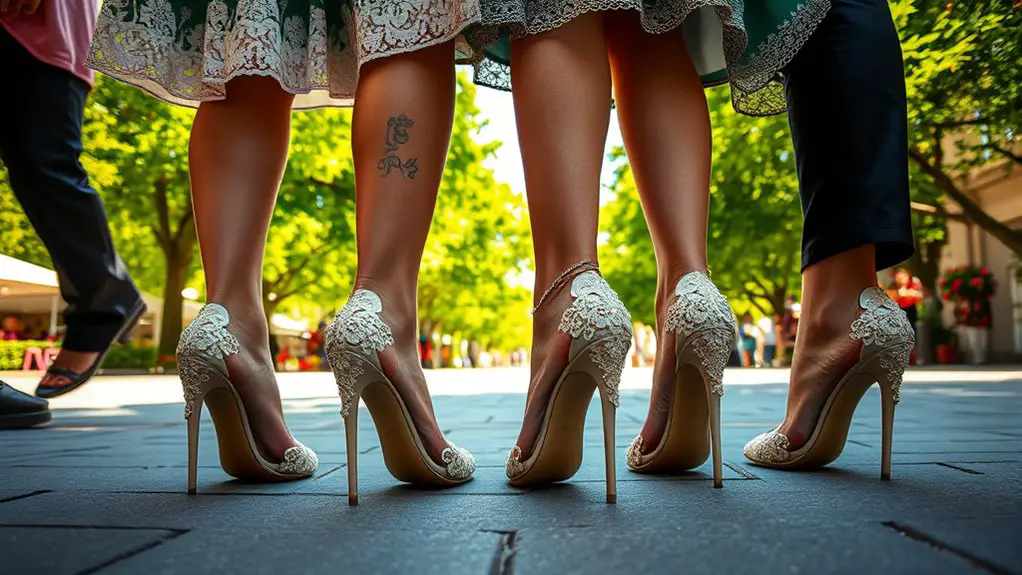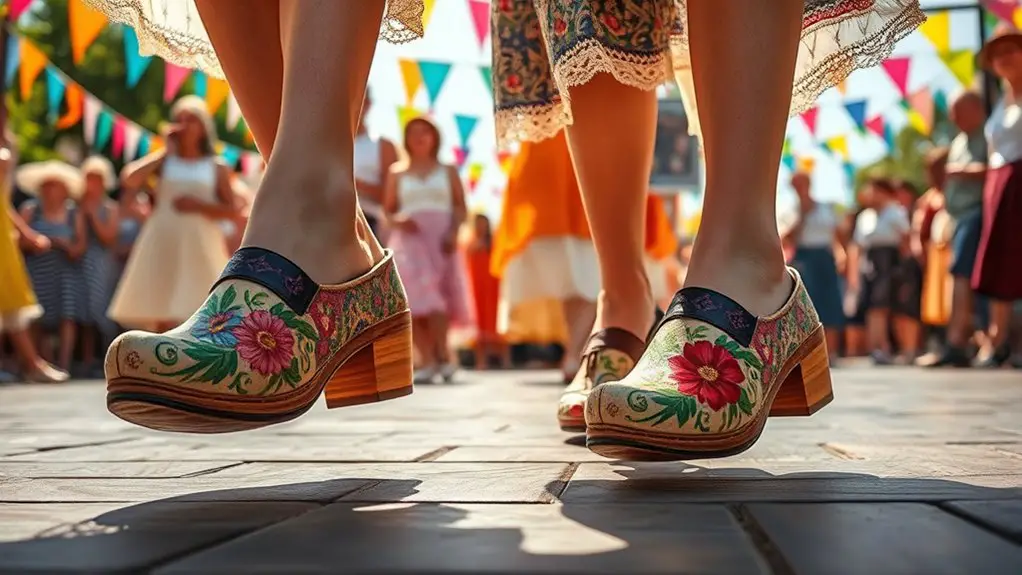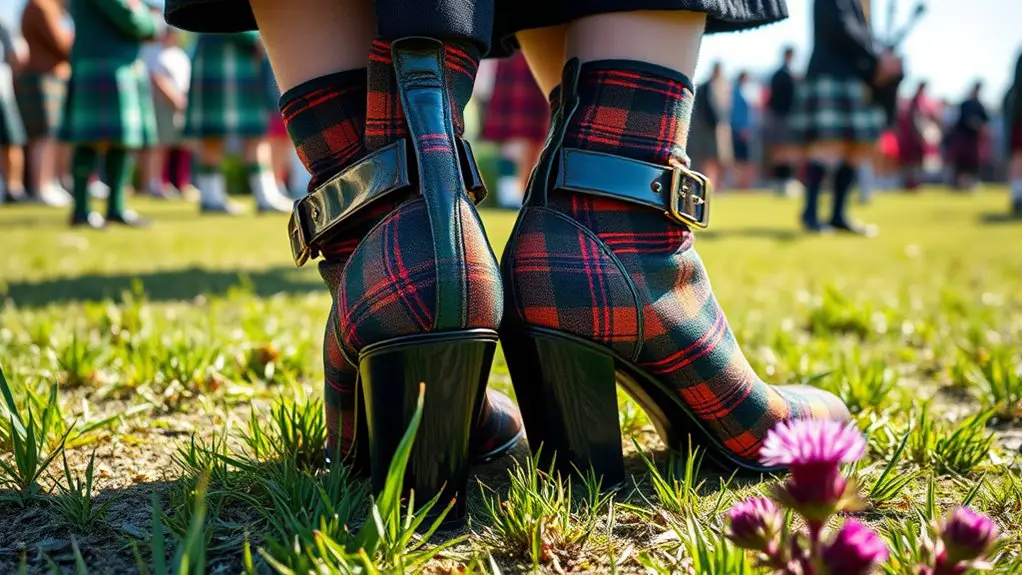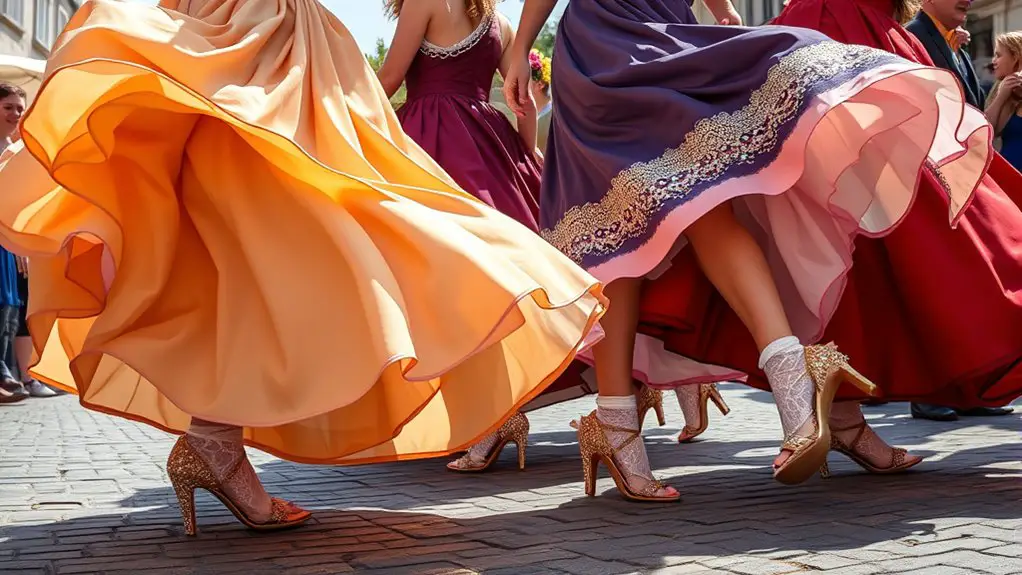Heels are styled in traditional European festivals as key elements that enhance both aesthetic and cultural significance. From the rhythmic allure of Spanish Flamenco shoes to the practical yet vibrant Dutch clogs, each style tells a story. Italian Renaissance footwear exudes elegance, while Scottish Ghillie brogues embody tradition amidst the Highland Games. These heels connect modern wearers with their heritage, showcasing a blend of history and identity. Explore the fascinating interplay between fashion and culture further.
The Significance of Heels in European Culture

While you might think of heels as merely a fashion statement, their significance in European culture runs much deeper. Heels symbolize status, femininity, and even power, evolving from their origins in the 16th century when they were worn by aristocrats to elevate social standing. Initially designed for men, heels transformed into women’s fashion, reflecting a cultural shift where femininity was increasingly tied to aesthetics and allure.
As you explore various European festivals, you’ll notice how heels serve as cultural symbols, enhancing traditional attire and embodying the region’s historical evolution. In many cases, specific heel styles are linked to regional customs, showcasing craftsmanship and artistry. This connection to heritage not only celebrates collective identity but also reinforces societal roles. Therefore, heels are more than just footwear; they’re a narrative of cultural symbolism, reflecting the dynamic interplay between history, identity, and fashion in Europe.
Spanish Flamenco: The Art of the Shoe
When you immerse yourself in the vibrant world of Spanish Flamenco, you’ll quickly discover that the shoes worn by dancers are not just accessories; they are integral to the performance itself. Flamenco shoes are specially designed to enhance the rhythmic footwork, allowing each tap and stomp to resonate with the audience. Crafted through traditional craftsmanship, these shoes often feature a sturdy heel that provides both stability and an unmistakable sound, essential for the dance’s expressive nature.
The materials used, typically leather, contribute to the shoes’ durability and comfort, enabling dancers to perform for hours. The intricate designs, sometimes adorned with embellishments, reflect the cultural heritage of Spain. As the dancer’s feet move in sync with the music, the flamenco shoes create an auditory experience that captivates the audience, making them an indispensable element of the Flamenco art form. Essentially, these shoes are a celebration of tradition and artistry intertwined.
Dutch Clogs: Function Meets Festivity

Just as Flamenco shoes are essential to the passionate expression of Spanish dance, Dutch clogs represent a unique fusion of practicality and celebration in the Netherlands. These wooden footwear pieces embody a functionality focus, designed to protect feet while working in the fields or around water. Their sturdy construction guarantees durability, a vital aspect for the everyday laborer.
However, during festivals, Dutch clogs transform dramatically. They often feature festive designs, adorned with vibrant colors and intricate carvings that reflect local heritage and cultural pride. You’ll see them at parades and celebrations, where wearers blend tradition with festivity, turning a practical item into a symbol of joy and community spirit.
As you appreciate the versatility of Dutch clogs, it becomes clear that they’re not just functional; they’re a celebration of identity, connecting the past with the lively present in a uniquely expressive way.
Italian Renaissance: Elegance in Every Step
As you explore the Italian Renaissance, you’ll discover that footwear from this period isn’t merely a fashion statement; it embodies a rich tapestry of cultural significance and artistic expression. The heels worn by the Italian nobility showcased their status, emphasizing elegance and refinement in every step.
These shoes were often adorned with intricate designs, reflecting the artistry of the era. Here’s a closer look at key aspects of Renaissance fashion:
| Feature | Description |
|---|---|
| Materials | Luxurious leather, silk, and brocade |
| Designs | Pointed toes, elaborate embroidery |
| Heel Height | Varied from modest to dramatic |
In this context, heels became symbols of wealth and sophistication, allowing the Italian nobility to express their identity through meticulously crafted footwear. Each pair told a story, merging functionality with artistry, making every step a statement of power and beauty.
Scottish Highland Games: Tradition and Tartan

At the Scottish Highland Games, traditional Highland dress showcases a rich tapestry of culture, with tartan patterns representing various clans. You’ll notice that footwear varies greatly, from sturdy boots to more elegant styles, each serving a unique purpose while reflecting the event’s heritage. The importance of heels in this situation goes beyond aesthetics; they symbolize the melding of tradition and contemporary fashion within this vibrant celebration.
Traditional Highland Dress
When attending Scottish Highland Games, you can’t help but be captivated by the vibrant display of traditional Highland dress, where tartan patterns and cultural significance intertwine. The attire reflects highland heritage, showcasing the pride of each clan. Men often wear kilts in their clan’s tartan, paired with sporrans, while women don elegant tartan dresses or skirts, adorned with intricate accessories.
| Element | Description | Emotional Impact |
|---|---|---|
| Tartan Patterns | Rich colors and unique designs | Pride and nostalgia |
| Kilts | Symbol of masculinity and tradition | Connection to ancestry |
| Accessories | Sporrans, belts, and brooches | Celebration of culture |
| Footwear | Traditional shoes complete the look | Honor the past |
This attire not only beautifies the event but also honors footwear traditions rooted in history.
Footwear Variations and Styles
While the traditional Highland dress captivates with its vibrant patterns and cultural significance, the footwear choices at the Scottish Highland Games play an equally important role in completing the ensemble. The blend of style and functionality is evident in the variations of footwear, showcasing both historical roots and modern footwear innovations.
- Ghillie Brogues: These traditional shoes feature laces that wrap around the ankle, emphasizing heel craftsmanship.
- Kilt Hose: Often worn with brogues, these knee-high socks add warmth and style.
- Brogue Boots: Offering more support, they’re ideal for outdoor activities.
- Dress Shoes: Reserved for formal occasions, they complement the kilt beautifully.
- Modern Sneakers: A recent addition, they provide comfort for younger participants.
Each variation reflects a deep respect for tradition while embracing innovation.
Cultural Significance of Heels
Although heels might not be the first footwear choice that comes to mind at the Scottish Highland Games, their presence carries cultural weight and historical significance. In the context of these vibrant festivals, heels symbolize the cultural evolution of Scottish attire, reflecting a blend of tradition and modernity. While practical footwear like brogues often takes center stage, the occasional use of heels showcases a nod to elegance and femininity amid the ruggedness of the Games. This footwear symbolism transcends mere aesthetics, representing a connection to heritage and identity. By incorporating heels, participants subtly acknowledge the interplay between traditional Scottish culture and contemporary influences, enriching the overall narrative of the Highland Games and celebrating Scotland’s unique fashion legacy.
Portuguese Folk Dances: Rhythm and Heels
When you watch Portuguese folk dances, you’ll notice how integral the right footwear is to the performance. Heels not only enhance the rhythm of the dance but also carry deep cultural significance, symbolizing tradition and community. Understanding the role of these shoes can illuminate the connection between movement and heritage in Portugal’s vibrant dance scene.
Dance Footwear Essentials
As you immerse yourself in the vibrant world of Portuguese folk dances, it’s essential to recognize how the right footwear can enhance both performance and comfort. Different dance styles call for specific heel materials and designs that support the unique movements and rhythms. Here are some essentials to take into account:
- Heel Height: Choose a height that balances elegance and stability.
- Material: Opt for durable leather or suede for flexibility.
- Fit: Guarantee a snug fit to prevent blisters during lively performances.
- Weight: Lightweight shoes enhance agility and speed.
- Sole Design: A textured sole provides grip and control on various surfaces.
Selecting the right dance footwear not only elevates your style but also enhances your overall experience in these traditional dances.
Cultural Significance of Heels
Heels in Portuguese folk dances aren’t merely a fashion statement; they embody the rhythm and cultural heritage of the performances. These shoes serve as a crucial connection to the past, reflecting the cultural evolution of Portuguese traditions. The distinctive sound of heels striking the ground creates a percussive element, enhancing the overall dance experience. As you watch these performances, you’ll notice how the dancers’ movements synchronize with the rhythm, showcasing a deep-rooted connection to their ancestry. The heels, adorned with vibrant designs, also represent regional identities, transforming them into powerful symbols of pride. By embracing these styles, dancers honor their heritage while simultaneously making bold fashion statements that resonate with contemporary audiences. This interplay of culture and style enriches the festival atmosphere.
French Festivals: Chic Styles and Historical Flair
While attending French festivals, you’ll quickly notice that style transcends mere fashion; it’s a celebration of culture and history. French elegance shines through as attendees don chic ensembles, often featuring historical footwear that echoes the nation’s rich heritage.
The intricate relationship between heels and tradition becomes apparent as you observe:
- Classic Pumps: Symbolizing sophistication and grace.
- Brocade Heels: Reflecting the opulence of bygone eras.
- Flat Mules: Offering comfort while maintaining style.
- Ankle Boots: A modern twist on traditional designs.
- Strappy Sandals: Perfect for summer festivities, blending chic with practicality.
Each choice contributes to a narrative, connecting the past to the present. As you navigate through these festivals, you’ll appreciate how footwear not only enhances your outfit but also embodies the historical flair that defines French culture.
German Oktoberfest: Practicality and Playfulness
When you step into the lively atmosphere of Oktoberfest, the blend of practicality and playful style becomes immediately evident in the footwear choices of attendees. You’ll notice that many opt for practical styles like sturdy boots and comfortable flats, designed to withstand hours of walking and dancing on the festival grounds. These choices reflect a keen awareness of the festive environment, where the focus is on enjoyment rather than discomfort.
Yet, there’s also a whimsical side to the footwear. Playful designs adorn traditional outfits, with colorful patterns, embellishments, and even themed motifs that capture the spirit of the celebration. Girls might wear embellished clogs that echo the region’s heritage, while guys might sport vibrant laces or playful socks to add flair to their lederhosen. This fusion of practicality and playfulness not only enhances comfort but also elevates the festive atmosphere, making every step a celebration in itself.
Eastern European Folk Festivals: Colorful Expressions
As you immerse yourself in the vibrant atmosphere of Eastern European folk festivals, the footwear choices reveal a rich tapestry of cultural expression. Colorful footwear plays a central role in showcasing regional costumes, reflecting the unique dance styles and traditions of each area. These choices are more than mere aesthetics; they embody the cultural heritage of the communities.
Footwear at Eastern European folk festivals beautifully reflects cultural heritage, showcasing vibrant traditions and regional identities through colorful designs.
Key features of Eastern European folk footwear include:
- Handcrafted details that echo local traditions
- Bright colors that symbolize joy and celebration
- Sturdy materials designed for dynamic dance movements
- Ornate embellishments representing regional identity
- Practical designs that accommodate traditional folk attire
In these vibrant celebrations, every shoe tells a story, connecting the past with the present, and honoring the intricate festival traditions that define Eastern European culture.
Connecting Generations: Heels as Cultural Heritage
When you explore the historical significance of heels, you’ll find they’re not just footwear but symbols of tradition across generations. In various European festivals, regional variations showcase unique styles that reflect local culture and heritage. These heels serve as a tangible connection, linking the past with the present and enriching the festival experience.
Historical Significance of Heels
Though often viewed through a modern lens of fashion, heels carry a rich tapestry of historical significance that connects generations and cultures. Their historical evolution reveals how various societies have embraced and adapted them over time.
Consider these cultural adaptations:
- Persian cavalry: Originally practical for riding, heels symbolized power.
- European courts: Elevated status, with intricate designs showcasing wealth.
- Flappers of the 1920s: A symbol of liberation, redefining femininity.
- Military usage: Heels offered stability and authority in uniforms.
- Modern fashion: Continues to reflect societal values and identity.
Through these examples, you see how heels transcend mere footwear, embodying a complex heritage that enriches cultural narratives across generations.
Symbol of Tradition
Heels have evolved beyond mere fashion statements to become powerful symbols of tradition, connecting generations through shared cultural practices. In many European festivals, these heritage footwear pieces serve as vessels of cultural symbolism, embodying the values, stories, and artistry of a community. When you slip on a pair of intricately designed heels, you’re not just wearing shoes; you’re participating in a legacy that has been passed down through generations. Each style reflects historical significance and local craftsmanship, reminding you of the artisans who meticulously created them. Embracing these traditional heels allows you to celebrate your roots and honor those who came before you, reinforcing a sense of identity and belonging within the vibrant tapestry of European culture.
Regional Variations and Styles
As you explore the diverse landscape of European festivals, you’ll notice that regional variations in heel styles not only reflect local aesthetics but also tell rich stories of cultural heritage. These differences embody unique cultural heel symbolism, connecting generations through tradition.
Consider the following aspects of regional heel aesthetics:
- Materials: Local crafts influence heel materials, from leather in Italy to wood in Scandinavia.
- Height: Different cultures favor varying heights, symbolizing social status or festive spirit.
- Color: Bright colors may represent joy in one region while muted tones signify solemnity in another.
- Decorations: Intricate designs often convey local folklore or historical narratives.
- Footwear Type: Folk shoes versus modern heels highlight the shift from tradition to contemporary fashion.
These elements showcase how heels function as a living expression of cultural identity.
Frequently Asked Questions
What Materials Are Commonly Used in Festival Heels Across Europe?
When considering festival heels, you’ll often find leather craftsmanship at the forefront, offering durability and style. Vintage designs frequently emerge, blending traditional aesthetics with modern flair, ensuring your footwear stands out while celebrating cultural heritage.
How Do Heel Styles Vary by Regional Festival Traditions?
Heel styles reflect regional variations, with each festival’s significance influencing designs. You’ll notice vibrant colors in Spain’s flamenco, sturdy yet elegant styles in Germany’s Oktoberfest, and delicate heels in Italy’s cultural celebrations, showcasing unique traditions and aesthetics.
Are There Specific Heel Heights Favored in European Festivals?
In European festivals, specific heel heights often reflect fashion trends and cultural significance. You’ll notice shorter heels for comfort in lively celebrations, while taller styles may symbolize elegance, showcasing tradition and regional pride in unique ways.
What Role Do Heels Play in Modern European Festival Fashion?
Heels in modern festival fashion aren’t just about height; they’re a blend of modern influences and cultural significance. You’ll notice how they elevate style, reflecting personal expression while connecting traditions with contemporary trends.
How Are Heels Incorporated Into Festival Costumes for Children?
When considering children’s footwear, heels are often integrated into festival costumes, reflecting cultural significance. You’ll notice how these elements enhance the overall aesthetic, allowing little ones to embrace traditions while expressing their unique styles.



